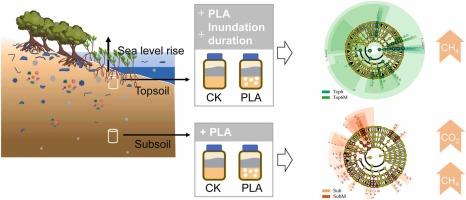Depth-dependent response of soil microbial community and greenhouse gas efflux to polylactic acid microplastics and tidal cycles in a mangrove ecosystem
IF 12.2
1区 环境科学与生态学
Q1 ENGINEERING, ENVIRONMENTAL
引用次数: 0
Abstract
The impacts of microplastics (MPs) on greenhouse gas emissions from mangrove soil remain poorly understood. Previous studies mostly focused on the topsoil in stable inundation state, ignoring the effects of natural tidal cycle and deep soil under different soil oxygen conditions. In this study, we analyzed soil microbial communities and greenhouse gas emissions from mangrove soils across various depths and tidal conditions (by adding seawater to create different inundation durations) in response to polylactic acid (PLA) MP exposure. Results indicated that PLA MPs addition enhances CO2 and CH4 release from the continuously anaerobic subsoil (100-120 cm). With increasing submersion duration, PLA MPs facilitate the emission of CH4 from the topsoil (0-5 cm). An elevated C:N ratio may promote microbial nitrogen mining and organic carbon mineralization, indicating the threat of PLA MPs to soil carbon and nitrogen pools. PLA MPs addition significantly altered the bacterial community structure and reduced bacterial diversity in the subsoil. Increases in the abundance and functioning of communities associated with methanogenesis and sulfate reduction contributed to the release of CO2 and CH4. The duration of inundation had no significant impact on the microbial community structure in the topsoil. These findings demonstrate the accelerating effect of PLA MPs on organic carbon mineralization and carbon release, which was critically regulated by the soil depth and tidal inundation.Environmental Implication
Microplastics (MPs), as emerging contaminants, are ubiquitous in mangrove ecosystems and may impact soil microbial communities and greenhouse gas emissions. However, the effects of MPs on microbial communities and carbon cycling in different soil layers remain inadequately elucidated, especially under the dynamic conditions of tidal cycles. This manuscript investigates the controlling effects of depth and tidal inundation on the impact of MPs on microbial communities and greenhouse gas emissions in mangrove soil. The findings are crucial for understanding the impact of MPs on the carbon pool in mangrove soils.

求助全文
约1分钟内获得全文
求助全文
来源期刊

Journal of Hazardous Materials
工程技术-工程:环境
CiteScore
25.40
自引率
5.90%
发文量
3059
审稿时长
58 days
期刊介绍:
The Journal of Hazardous Materials serves as a global platform for promoting cutting-edge research in the field of Environmental Science and Engineering. Our publication features a wide range of articles, including full-length research papers, review articles, and perspectives, with the aim of enhancing our understanding of the dangers and risks associated with various materials concerning public health and the environment. It is important to note that the term "environmental contaminants" refers specifically to substances that pose hazardous effects through contamination, while excluding those that do not have such impacts on the environment or human health. Moreover, we emphasize the distinction between wastes and hazardous materials in order to provide further clarity on the scope of the journal. We have a keen interest in exploring specific compounds and microbial agents that have adverse effects on the environment.
 求助内容:
求助内容: 应助结果提醒方式:
应助结果提醒方式:


